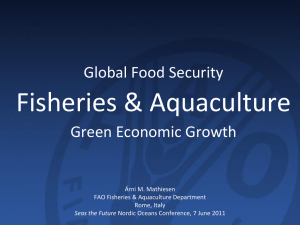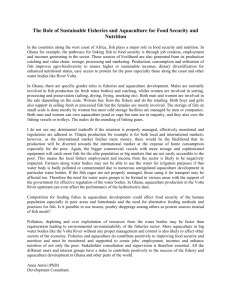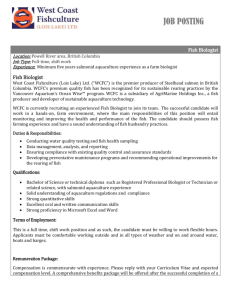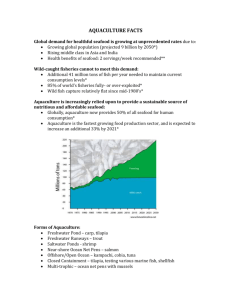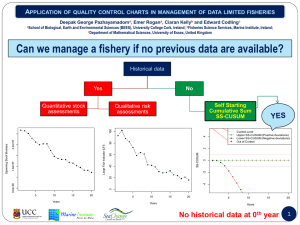Wild Fish Assemblages (local area)
advertisement
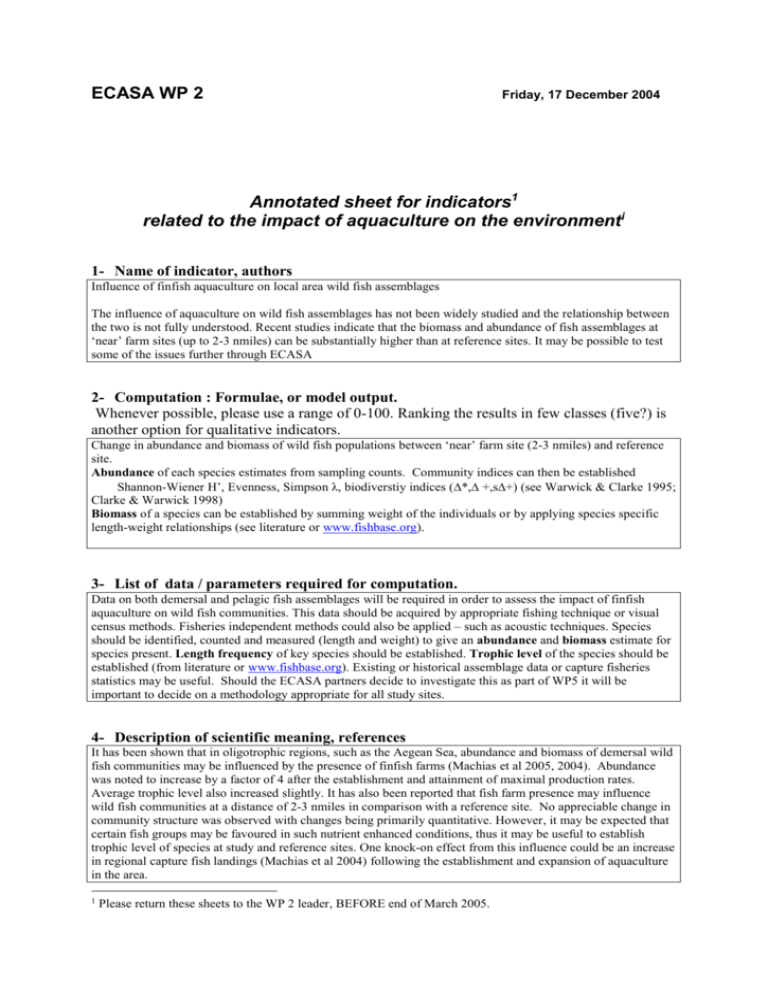
ECASA WP 2 Friday, 17 December 2004 Annotated sheet for indicators1 related to the impact of aquaculture on the environmenti 1- Name of indicator, authors Influence of finfish aquaculture on local area wild fish assemblages The influence of aquaculture on wild fish assemblages has not been widely studied and the relationship between the two is not fully understood. Recent studies indicate that the biomass and abundance of fish assemblages at ‘near’ farm sites (up to 2-3 nmiles) can be substantially higher than at reference sites. It may be possible to test some of the issues further through ECASA 2- Computation : Formulae, or model output. Whenever possible, please use a range of 0-100. Ranking the results in few classes (five?) is another option for qualitative indicators. Change in abundance and biomass of wild fish populations between ‘near’ farm site (2-3 nmiles) and reference site. Abundance of each species estimates from sampling counts. Community indices can then be established Shannon-Wiener H’, Evenness, Simpson λ, biodiverstiy indices (*, +,s+) (see Warwick & Clarke 1995; Clarke & Warwick 1998) Biomass of a species can be established by summing weight of the individuals or by applying species specific length-weight relationships (see literature or www.fishbase.org). 3- List of data / parameters required for computation. Data on both demersal and pelagic fish assemblages will be required in order to assess the impact of finfish aquaculture on wild fish communities. This data should be acquired by appropriate fishing technique or visual census methods. Fisheries independent methods could also be applied – such as acoustic techniques. Species should be identified, counted and measured (length and weight) to give an abundance and biomass estimate for species present. Length frequency of key species should be established. Trophic level of the species should be established (from literature or www.fishbase.org). Existing or historical assemblage data or capture fisheries statistics may be useful. Should the ECASA partners decide to investigate this as part of WP5 it will be important to decide on a methodology appropriate for all study sites. 4- Description of scientific meaning, references It has been shown that in oligotrophic regions, such as the Aegean Sea, abundance and biomass of demersal wild fish communities may be influenced by the presence of finfish farms (Machias et al 2005, 2004). Abundance was noted to increase by a factor of 4 after the establishment and attainment of maximal production rates. Average trophic level also increased slightly. It has also been reported that fish farm presence may influence wild fish communities at a distance of 2-3 nmiles in comparison with a reference site. No appreciable change in community structure was observed with changes being primarily quantitative. However, it may be expected that certain fish groups may be favoured in such nutrient enhanced conditions, thus it may be useful to establish trophic level of species at study and reference sites. One knock-on effect from this influence could be an increase in regional capture fish landings (Machias et al 2004) following the establishment and expansion of aquaculture in the area. 1 Please return these sheets to the WP 2 leader, BEFORE end of March 2005. No data seems to be available on other regions or environment types. It might be expected that the community response might vary across regions with different environmental conditions. The scale at which changes in communities occur may also vary across regions/environmental conditions. Alteration in wild fish communities may also vary with site (degree of enclosure, exposure, tidal influences etc) and regional farm production levels. Clarke KR, Warwick RM (1998). A taxonomic distinctness index and its statistical properties. Journal of Applied Ecology 35, 523-531 Machias A, Karakassis I, Giannoulaki M, Papadopoulou KN, Smith CJ and Somarkis S (2005). Response of demersal fish communities to the presence of fish farms. Marine Ecology Progress Series 288, 241-250 Machias A, Karakassis I, Labrapoulou M, Somarkis S, Papadoploulou KN, Papaconstantinou C (2004). Changes in wild fish assemblages after establishment of a fish farming zone in an oligotrophic marine ecosystems. Estuarine and Coastal Shelf Science 60, 771-779 Warwick RM, Clarke KR (1995). New ‘biodiversity’ measures reveal a decrease in taxonomic distinctness with increasing stress. Marine Ecology Progress Series 129, 301-305 5- Range of validity; please provide a description of the field of validity for the indicator, its limits, endpoints. Careful explanations should be given in a table about the correspondence between the computed values and the impact (from positive effect, no impact , moderate impact, high impact, unacceptable impact). As yet there are no thresholds for levels of impact associated with the influence of finfish aquaculture on wild fish populations. This is largely due to a lack of literature on the subject. However, it may be possible to use ECASA to investigate this relationship further. 6 -Type of aquaculture on which this indicator applies Cage aquaculture 6- Relevant environments for this indicator Open sea Sheltered areas (bays, fjord, estuaries) Oligotrophic areas 8- Quotation. We will need to select the most appropriate indicators to be proposed for EIA and site selection. Please suggest a quotation for this indicator for the following criteria (from A, perfectly adequate, to E, not relevant), to help evaluating the indicator within WP 4. Additional comments are welcome. Direct relevance to objectives : The indicator selection must be closely linked to the Requirements of the EU: Use for environmental impact assessment and site selection. This aspect should be detailed. B Clarity in design. It is important that the selected indicators are defined clearly in order to avoid confusion in their development or interpretation. C Realistic collection or development costs : Indicators must be practical and realistic, and their cost of collection and development therefore need to be considered. This may lead to trade-offs between the information content of various indicators and the cost of collecting them. B High quality and reliability : Indicators, and the information they provide, are only as good as the data from which they are derived. B Appropriate spatial and temporal scale : Careful thought should be given to the appropriate spatial and temporal scale of indicators. B Obvious significance : The meaning and usefulness of the indicator should easily be understood by stakeholders. They would preferably use the levels of dissolved oxygen, rather of sulphide concentrations. C 9- Data and models related to this indicator, available for use by WP 4. Please list the data and models output available at local, national or regional scales for use by ECASA. They may not correspond to the more theoretical list asked for in §3. 10- Suggestions for use by WP 5. Give examples of indicators/aquaculture/environments which can be field-tested during the course of WP 5. Finfish aquaculture sites chosen for study as part of WP5 could be used to investigate this potential indicator. Methodology and approach should be appropriate for chosen study sites. This document is intended to be used for internal work on ECASA workpackage. The final indicator sheet may include a format somewhat different. Please suggest any improvement for both the cojntent and the form of this document. i





